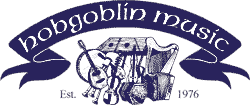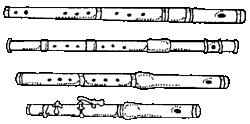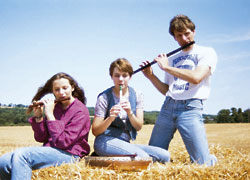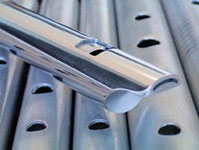
| THE HOBGOBLIN INFO SOURCE | |||
| HOBGOBLIN INDEX PAGE | HOBGOBLIN INFO INDEX | CATALOGUE CONTENTS | LOW WHISTLE ONLINE SALES | SECONDHAND PRICES |
| Low Whistle FAQ | ||
 |
ON THIS PAGE: Under Construction! Low Whistle Background Choosing your Whistle Low Whistle Makers RELATED PAGES: Care & Maintenance |
 |
|
© Copyright Hobgoblin Music 1983, 2000. This text may be freely distributed in whole or in part so long as the copyright holder is clearly acknowledged. Low WhistlesThe Low Whistle, so popular today as a result of the success Riverdance, was first made in the early 1970s by Bernard Overton, from aluminium tube. The instrument is usually tuned to D, an octave below the usual small D penny whistle, and twice as long (more or less the same size as a flute). We normally refer to whistles as low whistles if there is one available an octave higher. The G is the highest pitch commonly sold, so from G downwards we call the big ones Low whistles. Some instruments are made with a sliding head joint, which allows the instrument to be fine tuned. Not all players prefer this, and the most popular models are not tuneable. The Tin Whistle in its present form, has developed from the flageolet, popular in the last century. Itís origins of course are far older than that. The fingering is the same as on the wooden flutes and piccolos, D is the most useful key for folk tunes, but most tunings are available. Choosing a WhistleWhere to Start?The whistle is a diatonic instrument with simple fingering, and it's very easy to learn to play - easier than the recorder. If you're thinking about beginning the whistle, it is advisable to begin with a normal (high) whistle in the key of D. It is generally considered to be the easiest to play, and pretty much all of the tutor books you can buy are for whistles in D (although they can be used for any key). What Keys Can I Play In?Whistles generally play two octaves, and you can easily play in two keys on any whistle, for example on a D whistle you can play in D and G. Because many tunes go down below the key note, you will often find that the tune is easier to play in G than D on a D whistle, because D is the lowest note. This means you should also consider the alternative key of the whistle when choosing the key. C goes to F, A to D which is useful, F to Bb, G to C and so on. Are My Hands Big Enough!Some low whistles have a bigger stretch between the finger holes than others, so if you have small hands it is advisable to choose a whistle with closer holes, so that you won't have trouble reaching them. The following whistles do not have huge stretches: The Chieftain has been redesigned to bring the little finger hole closer in, and the Shaw Whistles have a smaller stretch too. Materials & ShapeMost low whistles are made from aluminium alloy tube, others from brass tube (which is the traditional material for small tin whistles, and in recent times also from plastic tubing. The alloy ones usually have the mouthpiece as an integral part of the tube, with a metal block inserted. Others have a plastic mouthpiece separately moulded. A whistle with a conical bore (Clarkes, Sweetone, Shaw) generally has a fairly breathy sound, while a straight bore gives a clearer sound. (All the rest) There are differences in tone between the whistles, but it is generally a matter of personal preference. Whistle MakersBernard OvertonThis was the original low whistle, handmade from aluminium alloy by Bernard Overton, the first of the low whistle makers Chieftain
Made by Phil Hardy's Kerry Whistle company, Chieftain whistles were the first mass produced alloy whistles and have sold prodigiously, bringing the low whistle to public attention around the world. The basic model is made from aluminium alloy with an integral mouthpiece which is not crimped flat, but rather left circular.
Chieftains are much easier to finger with the repositioned bottom hole.
All Chieftains are available with an adjustable tuning slide as an option Kerry
Kerry Whistles are the makers of Kerry, Kerry Pro and Chieftain whistles which are some of the most popular instruments we have ever sold. The Kerry Pro whistles were handmade by Phil Hardy but they are no longer made, while the other models are still produced in his workshops. All Kerry Pro whistles have a 2 part tuneable body. Phil is a fine musician and used to test every Kerry Pro before sending it out.Michael McGoldrick plays a Kerry Pro whistle The Kerry is made with a moulded plastic mouthpiece on an aluminium tube and are sold at a budget price. The sound is a little different from the all aluminium models, but it is not necessarily inferior Brian Howard
Brian Howard, also well known as a pipemaker, has been one of the pioneers of low whistle making. These are the new improved design with modified mouthpiece. Howard instruments have a nickel plated brass tube with a black plastic mouthpiece. Susato
Susato whistles, made of plastic, and available high or low, in several different keys are excellent value. Because they are plastic, they are never out of tune, and they have a clear, loud and focussed tone, ideal for sessions or recording. The Dublin model comes in one piece, and the Kildare in two, so that the tuning can be adjusted if you are playing along with others. Tony Dixon
Tony Dixon is based in Devon, and makes a range of flutes and whistles including low whistles from black plastic tubing. One useful model is a tuneable instrument with interchangeable flute and whistle heads. Other MakersThe Shaw whistle, a hand made cousin of the Clarke, has a wooden block in the mouthpiece, which gives a breathy tone, and is available in most keys, high or low. Other makers of low whistles we are aware of include Cillian O'Brian, Blazey, Thin Weasel, Chris Abell, and many more.. Back to the Top of the Page |